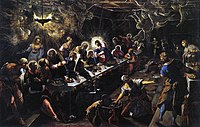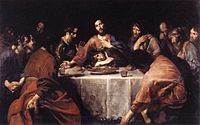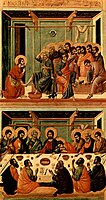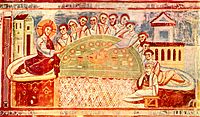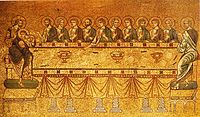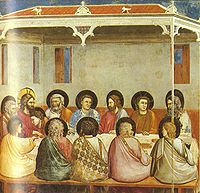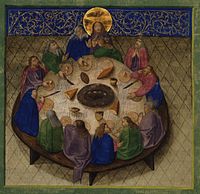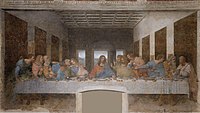Last Supper in Christian art

The
The Last Supper was depicted both in the

There are two major scenes shown in depictions of the Last Supper: the dramatic announcement of the
Setting
The earliest known written reference to the Last Supper is in Paul's First Epistle to the Corinthians (11:23–26), which dates to the middle of the first century, between AD 54–55.[6][7] The Last Supper was likely a retelling of the events of the last meal of Jesus among the early Christian community, and became a ritual which referred to that meal.[8] The earliest depictions of such meals occur in the frescoes of the Catacomb of Rome, where figures are depicted reclining around semi-circular tables.[2] In spite of near unanimous assent on the historicity of the evidence, one scholar comments that "The motif of the Last supper appears neither among the paintings of the catacombs nor the sculptures on sarcophagi ... The few frescos in the catacombs representing a meal in which Christ and some of the disciples participate show not the Last supper but refer to the future meal promised by the exalted Christ in his heavenly kingdom", seeing the subject’s depiction as beginning in the 6th century.[9]
A clearer case is the mosaic in the Church of Sant' Apollinare Nuovo in Ravenna, Italy, where a similar meal scene is part of a cycle depicting the life of Jesus and involves clear representation of him and his disciples.
By the Renaissance, the Last Supper was a popular subject in Italian art, especially in the refectories of monasteries. These depictions typically portrayed the reactions of the disciples to the announcement of the betrayal of Jesus.[2] Most of the Italian depictions use an oblong table, rather than a semi-circular one, and Judas is sometimes shown by himself, clutching his money bag.[2]
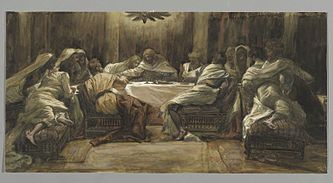
With an oblong table, the artist had to decide whether to show the apostles on both sides, with some seen from behind, or all on one side of the table facing the viewer. Sometimes only Judas is on the side nearest the viewer, allowing the bag to be seen. The placement on both sides was further complicated when
sculpture had further difficulties in devising a composition.Typically, the only apostles easily identifiable are Judas Iscariot, often with his bag containing thirty pieces of silver visible, John the Evangelist, normally placed on Jesus's right side, usually "reclining in Jesus' bosom" as his Gospel says (see below), or even asleep, and Saint Peter on Jesus's left. The food on the table often includes a paschal lamb; in Late Antique and Byzantine versions fish was the main dish. In later works the bread may become more like a communion host, and more food, eating, and figures of servers appear.[11]
Major scenes
There are two major episodes or moments depicted in Last Supper scenes, each with specific variants.[1] There are also other, less frequently depicted scenes, such as the washing of the feet of the disciples.[12]
The Betrayal

The first episode, much the most common in Western Medieval art,[13] is the dramatic and dynamic moment of Jesus' announcement of his betrayal. In this the various reactions produced by the Apostles and the depictions of their emotions provide a rich subject for artistic exploration,[1] following the text of Chapter 13 of the Gospel of John (21–29, a "sop" is a piece of bread dipped in sauce or wine):
21 When Jesus had thus said, he was troubled in the spirit, and testified, and said, Verily, verily, I say unto you, that one of you shall betray me.
22 The disciples looked one on another, doubting of whom he spake.
23 There was at the table reclining in Jesus' bosom one of his disciples, whom Jesus loved.
24 Simon Peter therefore beckoneth to him, and saith unto him, Tell [us] who it is of whom he speaketh.
25 He leaning back, as he was, on Jesus' breast saith unto him, Lord, who is it?
26 Jesus therefore answereth, He it is, for whom I shall dip the sop, and give it him. So when he had dipped the sop, he taketh and giveth it to Judas, [the son] of Simon Iscariot.
27 And after the sop, then entered Satan into him. Jesus therefore saith unto him, What thou doest, do quickly.
28 Now no man at the table knew for what intent he spake this unto him.
29 For some thought, because Judas had the bag, that Jesus said unto him, Buy what things we have need of for the feast; or, that he should give something to the poor.
30 He then having received the sop went out straightway: and it was night.
Especially in Eastern depictions, Judas may only be identifiable because he is stretching out his hand for the food, as the other apostles sit with hands out of sight, or because he lacks a halo. In the West he often has red hair. Sometimes Judas takes the sop in his mouth directly from Jesus' hand, and when he is shown eating it a small devil may be shown next to or on it.[14] The betrayal scene may also be combined with the other episodes of the meal, sometimes with a second figure of Christ washing Peter's feet.[15]
The Eucharist
The second scene shows the institution of the
- Depictions of The Eucharist
-
Communion of the Apostles, by Fra Angelico, with donor portrait, 1440–41
-
The first Eucharist, byJuan de Juanes, mid-late 16th century
-
Tintoretto, Last Supper, 1592–94, showing the Communion of the Apostles
-
Valentin de Boulogne, 1625–26
Washing of feet and farewell
The
The last episode, far less commonly shown, is the
- Depictions of Washing of feet and farewell
-
Christ washing the Apostles' feet in the Gospels of Otto III, 10th–11th century
-
Christ Reasoning with Peter as he washes his feet, byGiotto di Bondone (Scrovegni Chapel), c. 1304–06
-
Last Supper and Washing of Feet, Maestà by Duccio, 1308–11
-
Jesus "saying farewell", Maestà by Duccio, 1308–11
Key examples

Pietro Perugino's depiction (c. 1490) in Florence shows Judas sitting separately, and is considered one of Perugino's best pieces.[21] It is located in the convent that housed noble Florentine girls.[22] Upon its rediscovery was initially attributed to Raphael.

There are far more numerous secondary figures in the huge painting now called The Feast in the House of Levi by Veronese. This was delivered in 1573 as a Last Supper to the Dominicans of Santi Giovanni e Paolo, Venice for their refectory, but Veronese was called before the Inquisition to explain why it contained "buffoons, drunken Germans, dwarfs and other such scurrilities" as well as extravagant costumes and settings, in what is indeed a fantasy version of a Venetian patrician feast.[26] Veronese was told that he must change his painting within a three-month period - in fact he simply changed the title to the present one, still an episode from the Gospels, but a less doctrinally central one, and no more was said.[27]
The
In Rubens' Last Supper, a dog with a bone can be seen in the scene, probably a simple pet. It may represent faith, dogs are traditionally symbols of and are representing faith.[30] According to J. Richard Judson the dog near Judas, it perhaps representing greed, or representing the evil, as the companion of Judas, as in John 13:27.[31]
The Sacrament of the Last Supper, Salvador Dalí's depiction, combines the typical Christian themes with modern approaches of Surrealism and also includes geometric elements of symmetry and polygonal proportion.[32]
Gallery
- Depictions of The Last Supper in Christian art
-
Byzantine mosaic ofwashing the disciples' feet, at the Monreale Cathedral, Italy
-
Judas reaches for the food; School of Monte Cassino, c. 1100, Sant'Angelo in Formis, Capua, still using Roman couches.
-
Saint Mark's Basilica, Venice, 13th century, Judas reaching out
-
Giotto, Scrovegni Chapel, 1305, with flat perspectival haloes; the view from behind causes difficulties, and John's halo has to be reduced in size.
-
Christ Washing the Feet of the Apostles by Meister des Hausbuches, 1475; only Judas (near right) lacks a halo.
-
Ottheinrich Folio, p. 40v: Last Supper, Mt 26:20–29
-
Last Supper by Domenico Ghirlandaio, 1480, depicting Judas separately
-
Last Supper by Pietro Perugino, depicting Judas separately, 1493–1496
-
Leonardo da Vinci'sLast Supper, 1498
-
Judas reaches for the food; Theophanes the Cretan, 16th century
-
Protestant version by Lucas Cranach the Elder, 1547, central panel of altarpiece of St. Mary's Church, Wittenberg, Germany. 16th century
-
Protestant version byElector of Saxonykneeling
-
Paolo Veronese, now called The Feast in the House of Levi, 1573
See also
- Ascension of Jesus in Christian art
- Christian art
- Art in Roman Catholicism
- The Reformation and art
Notes
- ^ ISBN 978-0-89236-727-6 pp. 254–259 Google books link
- ^ ISBN 978-90-429-0007-3 pp. 22–32 Google books link
- ^ a b Schiller, 40–41
- ^ Schiller, 24–38
- ISBN 978-0-8028-2416-5 pp. 52–56 Google books link
- ^ "Introduction to the Epistles to the Corinthians - Study Resources".
- ISBN 1-58051-111-2 p. 49 Google books link
- ^ Schiller, 27–28
- ^ Schiller, 37
- ^ Schiller, 31, 37
- ^ ISBN 978-0-89236-727-6 p. 252 Google books link
- ^ Schiller, 32-38
- ^ Schiller, 30–34, 37
- ^ Schiller, 32–33, 37–38
- ^ Schiller, 38–40
- ^ Schiller, 28–30
- ^ Schiller, 41–42
- ^ Schiller, 42–43
- Prado.
- ISBN 978-0-03-091932-9p. 254
- ISBN 880903726X p. 196 Google books link
- ^ ISBN 978-0-534-64114-6 pp. 382–383 Google books link
- ^ Leonardo da Vinci, the Last Supper: a Cosmic Drama and an Act of Redemption by Michael Ladwein 2006 pp. 27, 60. Google books link
- ISBN 1-86189-120-2 p. 234 Google books link
- ^ "Transcript of Veronese's testimony". Archived from the original on 2009-09-29. Retrieved 2011-04-18.
- ISBN 0-521-56568-5
- ^ Noble, 97–104; Schiller, 41
- ^ Schiller, 41
- ISBN 9780199352692.
- ISBN 0-905203-61-5p. 49
- ISBN 978-981-277-582-5 pp. 177–178 Google books link
References
- Noble, Bonny, Lucas Cranach the Elder: Art and Devotion of the German Reformation, University Press of America, 2009, ISBN 978-0-7618-4338-2
- ISBN 0-85331-324-5




